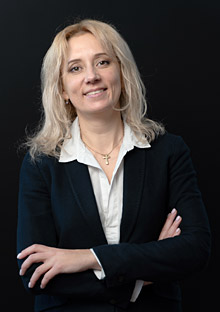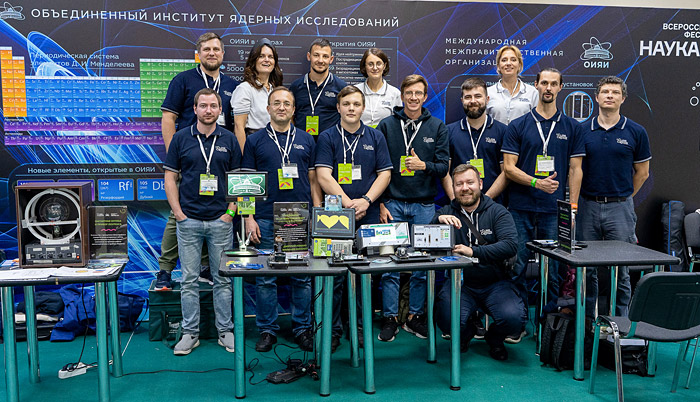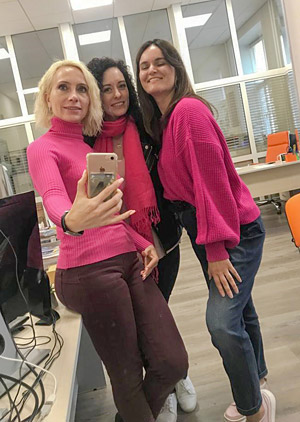
Electronic english version since 2022 |
The newspaper was founded in November 1957
| |
Year of teacher and mentor
A.Sushchevich: "Our goal
is to replenish the JINR personnel reserve"
The JINR star increasingly pulsates in the firmament of youth educational projects. These impulses are generated by the Social Communications Group of the JINR University Centre. Next year, the name of the group will change, its activities will expand and this fact served as the reason for an interview with its leader Anastasia Sushchevich.
The group was developed in 2017. Its "portfolio" includes the resumption of the work of the "105th Element" workshop as part of the Summer School ("Russian Reporter") at the Volga recreation centre, active participation in the scientific festivals Geek Picnic, "Science 0+" in Moscow, Kazan, cooperation within the framework of the International Year of the Periodic Table of Chemical Elements, representation of JINR at the exhibition "Russia" at VDNKh.
 Anastasia, we'll move on to bright projects later, but what constitutes routine work for the Social Communications Group?
Anastasia, we'll move on to bright projects later, but what constitutes routine work for the Social Communications Group?
- For us, it consists of information support for the events of the UC and partly of JINR - everything that concerns schoolchildren, students, teachers, parents. These are student internships, programmes, trainings, schools for students, as well as popular science events. It all starts with the preparatory phase, with the announcement, for which sometimes it is necessary to use all resources, including video shooting, editing and a series of interviews. During the event, we highlight some significant moments, interview students or lecturers, conduct excursions, for which, together with the laboratories, we have developed special routes, worked out the rules for visits and determined the staff of tour guides. Particularly, creative visitors manage to film a flash mob at excursion points that we use to popularize JINR among young people in our social networks. Upon completion of the event, we organize a post-campaign - posting interesting videos, interviews and so on to create resonance in the information field.
Tell us more about video content - who creates it and how?
- Since 2020, there has been a television studio in our group - two camera editors and a producer. Throughout the event, we collect video footage from which we edit short, bright stories for further distribution. We carry out this work not only for the needs of the UC, but sometimes also "to order", such as for AYSS, JINR Laboratories. One of the latest global tasks is the production of a video film about the long-term cooperation between JINR and a country, an associate member of JINR in preparation for the opening of the JINR Information Centre on the basis of a national research laboratory in this country. I won't reveal all the cards yet, but I can say that the development of a network of information centers is one of the new accents in our work. In order to provide the JINR IC with the required set of information materials, our group develops and then adapts materials on various media - from booklets and posters to videos.

A.Baydatsky, O.Radosteva, A.Sushchevich, E.Loboda, G.Sobolev
Can you give a structural picture of the group's work?
- Functionally, the work of our group is divided as follows. The first is message development, including design, copywriting, translation, proofreading. The second is the systematization of media and adaptation of materials to a specific information channel: digital (Internet and other digital channels), website, social media of our own and partners, especially universities. The third is direct production (printing, video shooting and so on) and further posting of the information message in any form on the information channel. Fourth - direct contact with our target audience. This is the organization and participation in popular science events: career forums in universities, career guidance meetings in schools, science festivals, including online inclusions (live broadcasts of lectures and excursions). This is how we differ from laboratory communication groups, disseminating information not only about our events, but also about JINR as a whole for a narrow target segment.
Also, as part of our work with schoolchildren and students, we have another type of activity - the production of motivating educational printing materials and souvenirs. During lectures and excursions, we motivate children to ask creative questions and make guesses in the answers, rewarding them with brochures, badges or magnets with JINR symbols.
And of course, we constantly put ourselves in the shoes of students and schoolchildren, their mentors, we think and look at the world through their eyes, we unravel their values and motivating factors.
Apparently, for the same purpose you invited the photo artist Mark Kozhura to JINR. Tell us a little about working with him, please.
- I was looking for just such an extraordinary photographer that produces non-trivial photographic works in order to show science at JINR to young people and spark their interest in JINR, facilities, research, projects and of course, people! Since the working day of a specialist of this level is very expensive, we had very limited time and material resources. We had to do the impossible - to show Mark the Institute in two working days. Yes, all seven laboratories! Yes, we wanted to show real scientists at work. That is why the shots included employees that were at their workplace at that moment. The photographic works were demonstrated at the JINR Cultural Center "Mir" in December last year (2022), on the Volga embankment in Dubna (2023), as well as in a number of cities and countries at exhibitions as part of joint events with JINR.
Last year, you held the "Letter to a Scientist" campaign. Remind our readers what it was and tell us about the responses, please.
- We carried out the campaign as part of the "Big change" project of the national project "Education" that gave us a reach of several hundred thousand people - this is the number of views we collected for the event. Children and even teachers from Russian and foreign schools wrote a letter to Academician Oganessian and asked him three questions. From the entire flow of letters, Yuri Tsolakovich chose the most interesting questions, the authors of which were subsequently invited to a meeting with the Academician and on an excursion to JINR. Among the winners was a student from Italy that joined the meeting online.
You had projects with the Educational Centre "Sirius"...
- Yes! In 2021, JINR signed a cooperation agreement with "Sirius". It should be noted that this is a place where more than 1000 schoolchildren - winners of All-Russian level Olympiads, the most motivated and gifted participants gather every month. A third of them represent natural sciences (physicists, mathematicians, programmers, biologists). The centre is equipped with the latest technology, scientific laboratories and leisure activities are thought out. Lecturers and mentors are scientists from different fields, but always of the first echelon. Thus, working with the children of "Sirius" means one hundred percent reaching the target audience. In 2021-2022, we participated in the remote online project "Lessons from real Nuclear Physics." More than 600 schoolchildren from 41 regions of Russia and 92 schools took part in assembling a Wilson chamber, registering particle tracks, their classification and developing a video presentation of the research results.
As part of the project, one of our volunteers, Dmitry Klimansky (VBLHEP), together with the UC TV studio, recorded a video instruction on assembling a Wilson chamber, Sergey Merts (VBLHEP) gave an introductory lecture on particle physics, as well as the theoretical part of the instructions. For a month, the participants studied information about JINR, particle physics, searched for and classified particles in the chamber they collected under the mentorship of their teacher.
And the second cycle of "Lessons of the present" with Inga Zinkovskaya (FLNP) in 2022 on the development of an interactive map of Russia with marked industrial enterprises. Schoolchildren from 40 regions of Russia (82 schools) were tasked with studying enterprises in their region and noting potential emissions of heavy metals into the atmosphere, as well as proposing innovative ideas for monitoring and cleaning the environment.
Our group provided all organizational, methodological and information support, as well as posting news before, during and after the project. As a result, more than 600 schoolchildren learned about the Institute, about neutron activation analysis and other FLNP projects. Such campaigns also meet our goals. And our goal is to replenish the JINR personnel reserve.
What do you focus on in your work?
- Breaking down stereotypes among students that science is very difficult or even boring. Nowadays, physics and mathematics departments at universities are experiencing a shortage of applicants, so our group is regularly invited to schools and universities to work with schoolchildren precisely with the goal of dispelling myths about science, telling and showing science at JINR, demonstrating the successes of scientists, motivating them to continue their education in scientific fields.
Do you attract many volunteers?
- Yes. The most active scientists and specialists can be noted, probably, about 30 people, but in total, there are about 50 volunteers. For example, to work at the "Science 0+" festival in Moscow at two sites, we form a landing party of 20 people, 10 for each location, who several thousand people pass through every day by. We also have a strong staff of lecturers for face-to-face and online events. Together with some information centres, the UC has developed work plans for the entire academic year to conduct online lectures and excursions. Not to mention the staff of tour guides. Today, there are so many applications from schools and universities for excursions that the queue is scheduled until May 2024. By the way, when choosing excursions for certain groups of schoolchildren, we always look at how prepared the children are and what their profile is. Our young scientists also don't like completely indifferent children. Thoughtless questions and empty eyes immediately demotivate the lecturer-tour guide. Therefore, we carry out preparatory work: at lectures in schools we hand out cards with questions, the answers to which can only be obtained by listening to the entire lecture. Or we organize a small competition to answer the most interesting question during the excursion and then reward the most curious with a memorable badge. As a result, we stopped seeing the backs of heads and mobile phones in lectures.

Team of JINR staff members at the "Science 0+" festival
Let's move on to changing the name and expanding the competence of the group.
- Since autumn, 2023, we have had another focus in our work - information centres, of which there are already 10. We develop, adapt, classify and provide information materials to information centres for their further use in working with local audiences. Thus, our activities began to focus on information support for educational initiatives. And these are not only lectures or excursions, these are also student internships, practical work at JINR with students that come through the information centre. In November and December, we had two such practices with participants from Kamchatka and Vladivostok - our two most active information centres. Young people also traditionally and often come from Vladikavkaz. We will continue this work and come up with new communication formats. Our new name tentatively is the Information Support Group for Educational Initiatives.
 |
| O.Radosteva, K.Russo, A.Zubova |
- Each member of our team has his own task. There is a specialist in organizing events. Until recently, Olga Radosteva has been a very good professional and bright assistant. Today, she has been replaced in this position by Anna Sumbaeva that organizes lectures. Anna Zubova is a video production producer, responsible for digital media, organizing the creation of video materials and posting content on social networks, replacing Evgenia Loboda in this post. There are two video editors - Gleb Sobolev and Alexander Baydatsky. The JINR Press Office often attracts participants to cover events; I think this speaks volumes about the quality of work of our employees and their willingness to help. There is an employee from South Africa at the UC, Karen Russo, without whom I cannot see the high-quality work of our group; she corrects all our English texts and adds good linguistic gloss. Karen helps not only us.
Do you attract employees from JINR Member States?
- Yes and not only from JINR Member States. Regular participants in our projects are young scientists and specialists from Kazakhstan, Armenia, Romania, Poland, the Czech Republic, Slovakia, Egypt, Belarus, Pakistan and Vietnam.
If we talk about the global goal, how many employees did come to JINR through your events?
- Working with schoolchildren, we understand that we will be able to see children among the JINR employees only in 7-8 years. Initiatives with students produce results a little faster. Since the main route to JINR for students is through the basic departments, and at present, also through information centres, it will be easier to count. And our plans include creating an automated database of students that have become employees to track the efficiency of our work. Today, I can absolutely say that there is an influx from MIPT, MEPhI, Moscow State University, Voronezh, Tomsk, Kazan universities, Dubna University and other universities. Soon, we will be able to collect statistics in more detail with reference to the events that served as the impetus for making the decision to work at JINR.
What should make you happy about the coming year 2024?
- I look forward with great enthusiasm to the completion and launch of the NICA collider complex, as well as information from DLNP when we will have a new accelerator for proton therapy. This is a very popular topic; in our work we often encounter a stir around it. People are interested, the topic worries many and our performance with the old accelerator is very impressive to people. And another big expectation is the opening of new information centres: in Mongolia, Vietnam, South Africa.
Galina MYALKOVSKAYA,
photo from the JINR UC archive